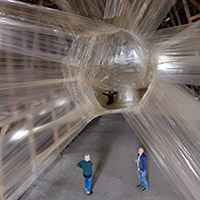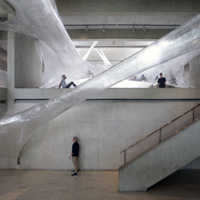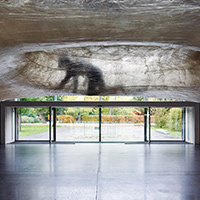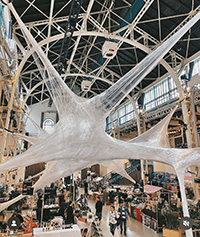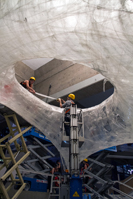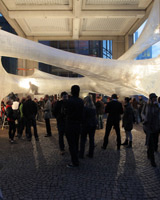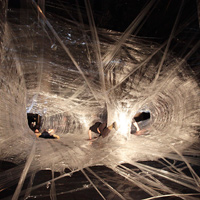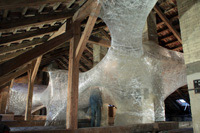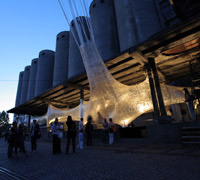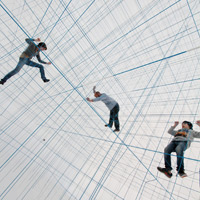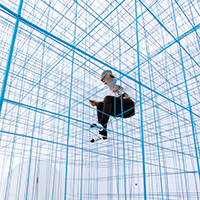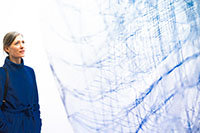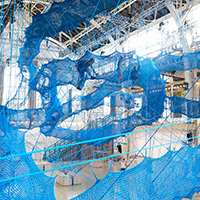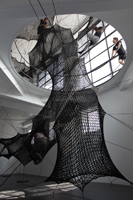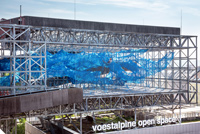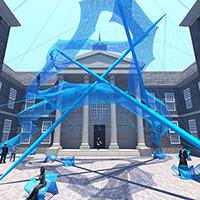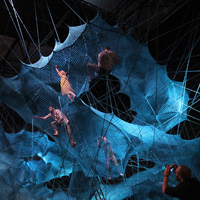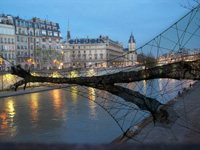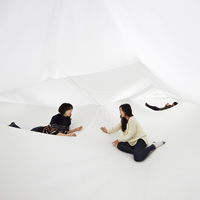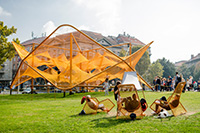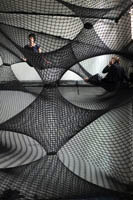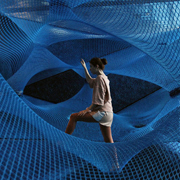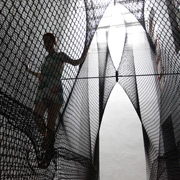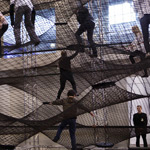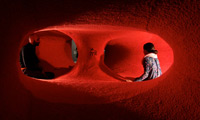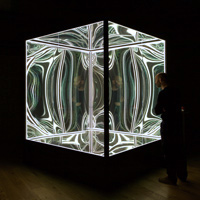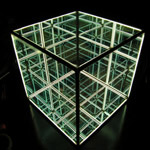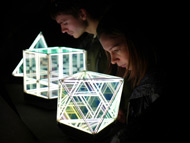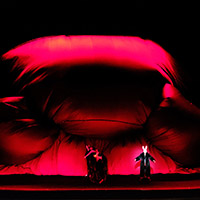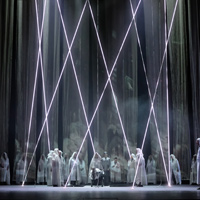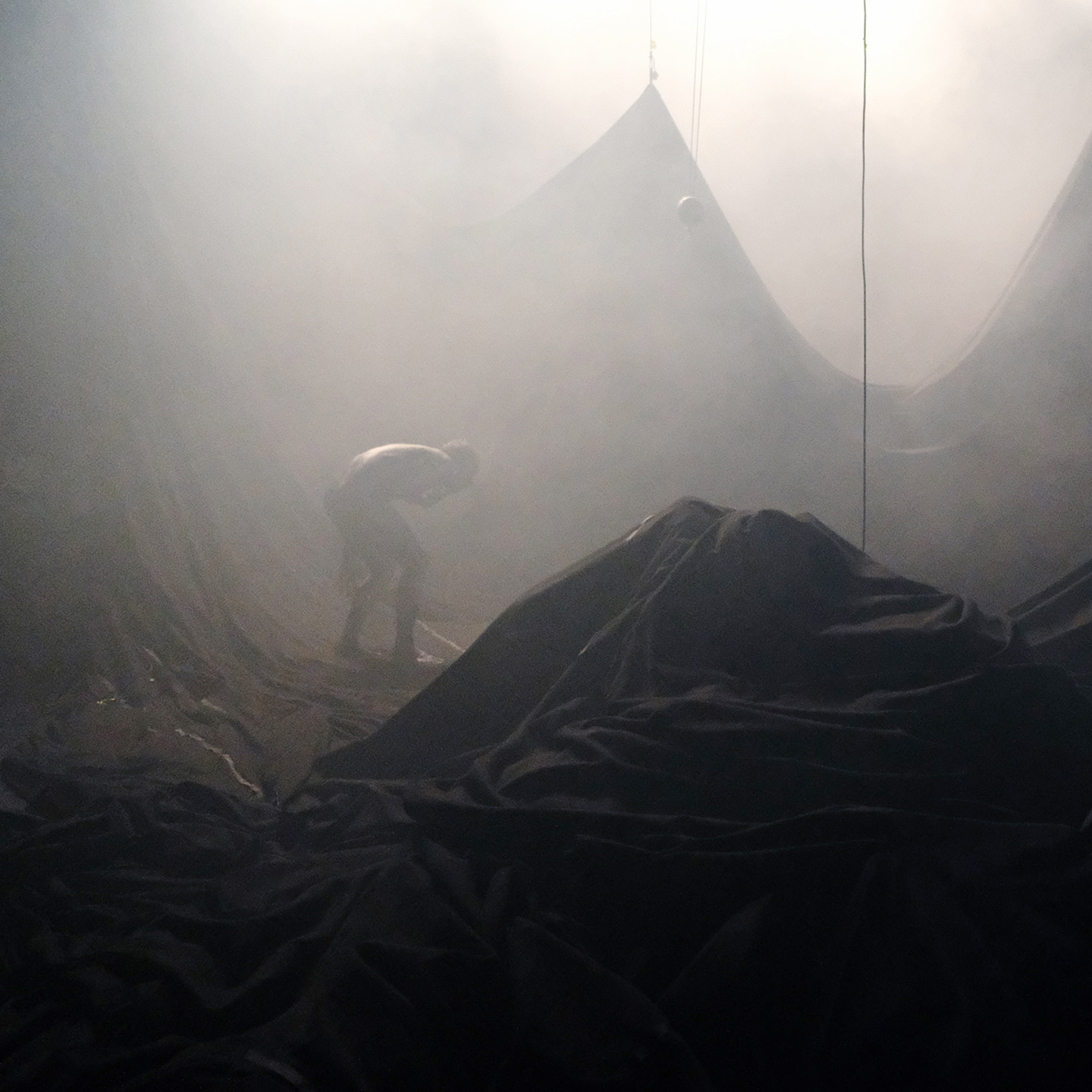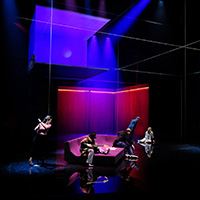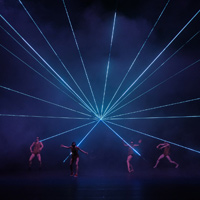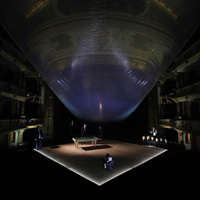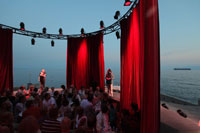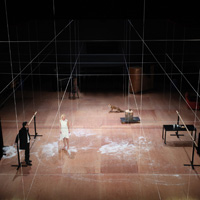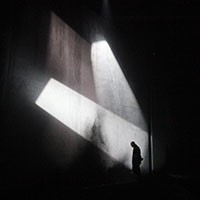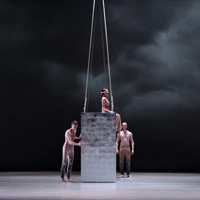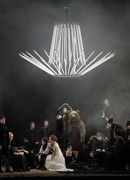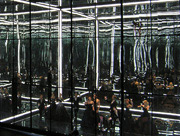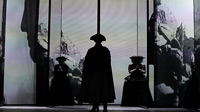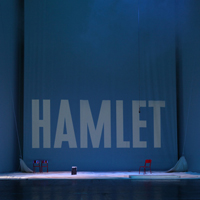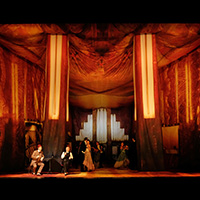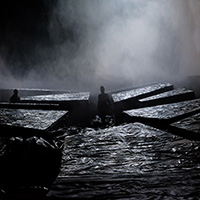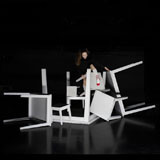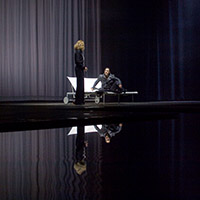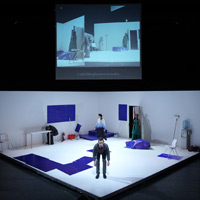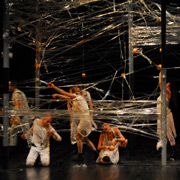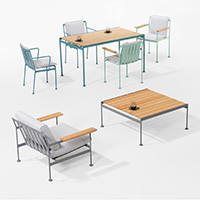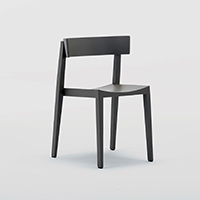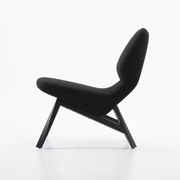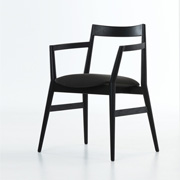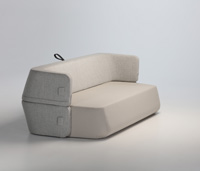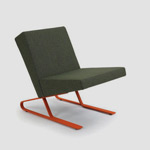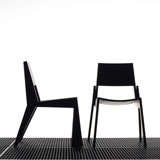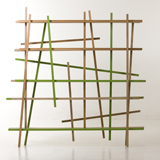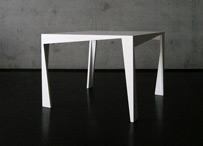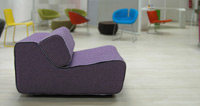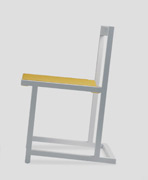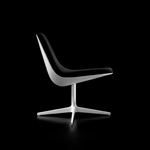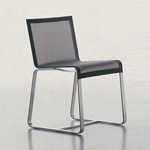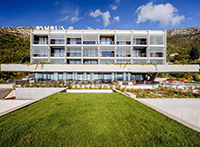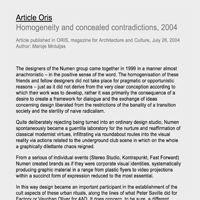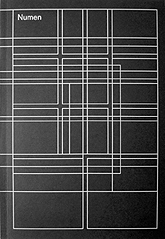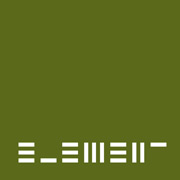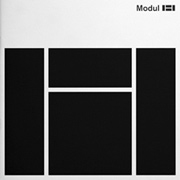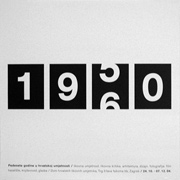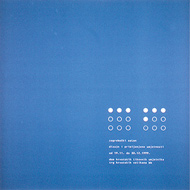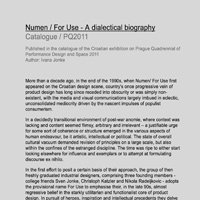Two-way mirrors and investigations of the perception of space What exactly are Numen-objects, structures made out of two-way mirrors and light, and what medium do they belong to? This research began in an unfinished project for the St Etienne Biennial that was meant to present the idea of the grid as formal principle. Then came a radical experiment for the set design for Dante’s Inferno as directed by Tomaž Pandur. Subsequently, the project went on into the development of lighting units.
In the version of today, what we have is a series of objects that derived from an investigative and analytical as well as a rational approach to design. The intention behind this avenue is that it should founded on the discovery of logically based formal rules and principles and be thoroughly ground in the modernist tradition of product design. But the project outgrew itself, and became an area of autonomous, primarily formal, research not predetermined by any pragmatic function.
The methodology of work on the project has been design-related throughout its life, aimed at the harmonisation of structural and formal factors. However, the function has been gradually been replaced by the fascination of the object itself and its perceptive and associative potentials. It is still an open question whether this object is going to find a new function or whether it will find a place for itself as an independent artefact.
But the many discoveries that work on the project has produced are enough for the current development phase to be documented, for an attempt at analysis to be made, without any need for a precise identification of the cultural location of the object. Most appropriate is for it to be called an investigation in perception, particularly the perception of space and the issue of perspective. Two-way mirrors, or one-way mirrors as they are also called, are a material that transmits the light from one side, reflects it from the other. The material is intriguing, beguiling and though-provoking for the optical, perceptive characteristics and the many connotations that derive from it. The phenomenon of the mirror is an archetype of a motif from which a broad range of references has developed, such as the seven years of bad luck, celebrated in literary moments such as Alice’s passage through the looking glass and on to theoretical models such as the mirror stage in psychoanalysis.
At the level of perception the mirror is connected with deep-level psychological processes and brought into numerous topics from cultural history. Identity and narcissism are the leading topics here, but unlike the main supports for mediated images, the television monitor and the silver screen, the mirror splits the authentic situation in space and time. The space of the mirror is not a field of a virtual but of a dematerialised reality. The perception of depth in the space is retained, although in the mirror image it no longer exists. Apparently paradoxically, in the mirror time is objectified, and space is relativised, being turned into plane surface.
The actual subject of transparency is one of the mythic issues of modernity, particularly because of the extensive use of glass in architecture, starting with projects like the famed Crystal Palace by architect Joseph Paxton built in Hyde Park in London in 1851, for the Great Exhibition. But the utopian idea of the transparency of glass as symbol of democracy has been deconstructed by the appearance of reflecting glass that is used in monumental corporate architecture.
There are other associations telling of the portentousness of two-way mirrors, as means of surveillance and repression – police stations, interrogation rooms. In such cases that have rapidly taken on broader semantic associations what is terrifying is the depersonalisation of power, the invisibility of those who decide on our fates, while we are faced with a mere image of our own powerlessness. The two-way mirror unites the phenomena of transparency and reflection, being ultimately ambivalent for it changes its basic characteristics depending on the positioning of light in front of or behind it. Changes in the thoroughgoing difference in the roles of observed and observer stage various situations in which one has to come face to face with one’s own image, with the view onto the other, or unease at any possible surveillance.
But the two-way mirror also features the unique capacity for its reflective and transparency properties to be gradated. It is not an unambiguous and inert material but range between its extremes depending on the illumination. For this reason, it lends itself to formal and perceptual research and application in various areas that include visuality.
Numen started to use the two-way mirror as a means for the investigation of geometrical spatial grids defined by tracts of light. Through the introduction of light within objects made from two-way mirrors, a manipulation of the dialectics of transparency and reflection is carried out. The application of orthogonal structures led first to the transformation of a light grid into perspective and hence the spatial phenomenon with the effect of multiplication ad infinitum.
The model of the square grid, one of the important motifs of Modernist art, particularly in the New York Conceptualist scene of the sixties acquired a specific expansion here. The square repetitive grid in numerous artistic investigations was suitable for testing out the topic of originality in conjunction with the premise that as a result of its ultimate neutrality and abstractness every grid is new irrespective of the form for no kind of linguistic content is inscribed in it. But at the moment when the grid takes off from the painter’s canvas or from the sculpture and becomes a space describable by light but really non-existent and infinite, the perspective of which changes depending on motion, the relation between observer and object comes out more emphatically. The hypnotic effect and the visual/spatial depth are so impressive that they shift observers from their singular, safe position into the grid of hyper-space, which has lost all the properties of the real physical environment defined primarily by the possibility of orientation, the definition of position. Most importantly, the perceptive definitions of up and down, basic phenomena for being able to cope in space, tend to disappear.
For this reason the experience of the displacement of the observer in the staging of hyperspace can give rise either to a sense of fascination with the infinity of perspectives or an extreme discomfort at destabilisation. The constructed perspective hyperspace is non-anthropological and practically without any meaning, except that which every observer creates for himself through the event of the non-spatial experience of perspective that expands diabolically in all directions.
Has the myth of perspective here been brought to an extreme and shown as the imposition of a mathematical and exclusively visual description of space to the detriment of the other senses, and then to the detriment of the social properties of the environment? On the other hand, Numen-objects reopen the old issue of the relation of language and space, narration and abstraction. In this case the emphasis is placed on the almost violent influence of the perspective scheme in the experience of the observer who formulates language and narration first of all through the primordial, biological feeling of orientation (or disorientation) and the individual capacity to manage in conditions that are extremely unnatural.
The disorientation produced by an abstract, non-anthropological geometry of hyperspace will challenge the effect of a perspective of anxiety. After the discovery of the perspective of anxiety in the form of a cube, Numen went on to develop its research in the direction of more complex and non-orthogonal geometries of Platonic bodies, regular polyhedra composed of equilateral surfaces. The grids that come into being become geometrically more complex and the perspective theme is suppressed in favour of a space that is not described by a three-dimensional Cartesian network as the ultimate modern model of the rationally organised world.
New Numen-objects work as ideograms of a non-Cartesian definition of space in which the vanishing points are multiplied to infinity and are increasingly ungraspable. The authority of the vanishing point is weakened, just as the geometrical net that is still based on ideal bodies is less universal. Platonic geometry still remains the basis of the project, but its development in the area of more complex forms produces results in which the effect of the perspective of anxiety and of sheer spatiality is reduced in favour of the multiplication of fractal, kaleidoscopic graphisms of light. This phenomenon refers to the likelihood of the deep encoding of human perception of space through a three-dimensional system. But to what extent is the encoding the result of its pragmatic perceptibility and to what extent is it culturally determined?
For example, from the viewpoint of tectonics of architecture, there are uncontentious concepts, like relationship of load and load-bearing elements, and the way in which the load is transferred to the ground that are analysed mathematically through Cartesian geometry. But the optimal ways of transferring physical forces depend on the materials and the way in which they are used, and are rarely orthogonal: for example, the spanning of large distances with reinforced concrete is done best with hyperbolic paraboloids. Orthogonal geometry is a symbol of universalist principles derived from religious or philosophy or the endeavour to bring the element of order and of system into the amorphy of nature. But Numen-objects destabilise this factor of system through the phenomenon of retinal delay and the perceptive deformation and pulsation of the object, which depends on the light conditions. When one is moving around the object, the effect of a distortion of the spatial grid is experienced, and it is felt that the virtually more distant areas of non-space are experienced with a delay, and that, really, they are more distant.
The answer to this phenomenon might be of a physiological or a cognitive nature. As is well known, the retina consists of two types of photo-receptors: the rods that register dark and peripheral vision and the cones that register colour and central vision. Depending on the combination of light and dark areas in the image, the photoreceptors react at different speeds, which can have a particular effect on geometrically powerful contrasts between light lines and dark surfaces.
The processes of the cognitive reconstruction of the image affect in turn the temporal shift effect in the perception of Numen-objects. Physiological and cognitive processes here work together with Numen-objects on the construction of spatial depth that really does not exist although it is defined by the light drawing and the rules of geometrical perspective. Thus retinal delay is a result of both physiology and mental processes. Through perceptive deception, it in turn abets the fake realistic effect of distance associated with the idealised universal principle of perspective. It is practically paradoxical for a mathematical model to have been invented to objectify reality as against perception actually backed up by the perceptive process itself. Numen objects, since the abandonment of the square grid, have endeavoured to test out the possibility of understanding space that is still geometrically ordered and structured but on the basis of an expanded conception of the grid. After the first object from the series, the cube, the deconstruction of the three dimensional perspective hierarchy developed. This deconstruction is primarily of a formal nature and a critical potential of a series of works that appears only interpretatively, through the shifting of the observer from a social and anthropological space to an abstract non-space within the object. The observer perceptively goes “through the looking glass” so as to be transferred to another, geometrically treated environment in which the systems that structure our world are symbolically stripped down.
To employ the vocabulary of Marc Auge: the interior of a Numen-object is the ultimate non-place. The two-way mirror refers here to some very basic questions – from the manner of interpreting and describing space and the surrounds to the meaning of geometry and rationalism for a world that we have ourselves constructed and defined. The non-space of a Numen-object, in spite of a fabric of light that is ever denser, is characterised by an almost terrifying void, the void of a perspective and geometrical order that acquires meaning only as occasion for and means of human reflection.
Maroje Mrduljaš

